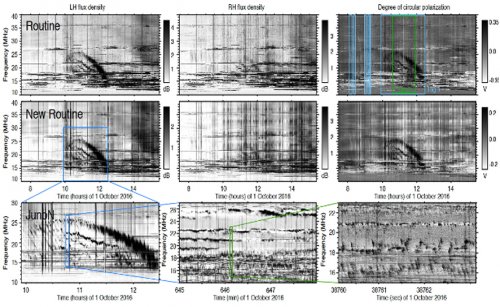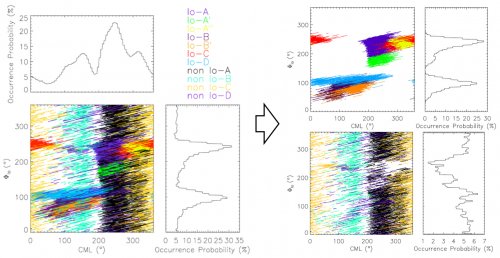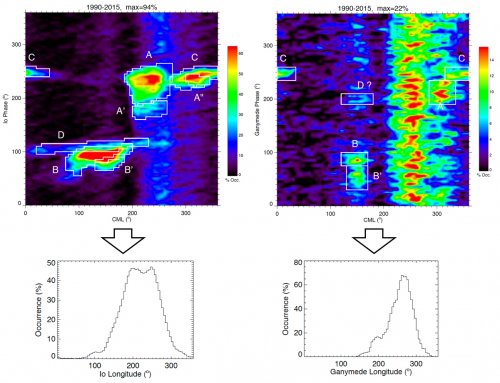A review of the recent scientific findings, the database and the receivers in service at the NDA has been published in the article [1],
from which is extracted the figure below.

Jupiter : a complex radiosource revealed by several decades of observation
In the case of Jupiter, whose sporadic decameter-wave emissions, discovered in 1955, cover the spectral range from around 1 to 40 MHz, the analysis of high time resolution data allows to study in detail the radio emission mechanism, that results from a cyclotron instability of energetic electrons moving in the Jovian magnetic field
The high temporal resolution compensates for the absence of angular resolution and literally allows to "follow" the movement of the electrons along the magnetic field lines, to determine their energy, and to obtain information on their acceleration in Jupiter’s magnetosphere.
By analyzing the data at low temporal resolution, it is possible to derive information on the topology and amplitude of the Jovian magnetic field as well as on the large-scale dynamic of the magnetosphere of Jupiter including its interaction with the solar wind and with Galilean satellites, in particular Io.
The electrodynamic interaction between Io and Jupiter was discovered in 1964 by the statistical analysis of the occurrence of Jupiter’s radio emissions as a function of the orbital phase of Io, and is the reference case of planet-satellite interactions.
"Occurrence catalogs" of Jupiter’s decametric emission were built and published (in A&A supplement series) since the start of NDA operations. The availability of more than 25 years of digital data motivated in 2016, thanks to the presence (and perseverance) of a Brazilian PhD student (M. Marquès) in the LESIA plasmas group, the construction of a database of Jovian radio emissions covering the longest duration to date (6,200 emission events recorded during > 8,000 observation sessions representing > 54,000 hours of observation) and containing much more detailed information than in the past.
The construction and first analysis of this database has been published in A&A [2].
It allowed us to characterize in detail the properties of the Io-dependent and Io-independent decametric emissions (probability of occurrence, duration, intensity, polarization, maximum frequency), including in particular the identification of new radio components (Figure 1).
The analysis of the occurrence of the emission as a function of the orbital phase of Galilean satellites other than Io then made it possible to detect for the first time very clearly the Jupiter-Ganymede electrodynamic interaction (Figure 2) and more marginally the interactions Jupiter-Europe and possibly Jupiter-Amalthea [3].
Hints of these interactions were deduced from spatial observations. The energy budget of these interactions will have implications on the search for radio emissions from exoplanets (article in preparation).

(à droite) Cette distribution se sépare en composantes dépendant de la position de Io (en haut) donc gouvernées par l’interaction électrodynamique Io-Jupiter, et composantes indépendantes de cette position (en bas) donc d’origine aurorale.
The NDA is operated today under the scientific responsibility of L. Lamy (LESIA) and the technical responsibility of L. Denis (USN). Its data is exploited by a team a little over half a dozen researchers at the Observatoire de Paris (LESIA) and their foreign collaborators.

(à droite) Mêmes diagrammes mais cette fois en fonction de la phase orbitale de Ganymède. Les composantes produites par l’interaction Ganymède-Jupiter apparaissent clairement, et se rassemblent également en un seul domaine de longitudes (environ 180°-300°).
[1] 1977-2017 : 40 years of decametric observations of Jupiter and the Sun with the Nançay decameter array, L. Lamy, P. Zarka, B. Cecconi, L.-K.
Klein, S. Masson, L. Denis, A. Coffre, C. Viou, Proceeding to the 8th International Workshop on Planetary, Solar and Heliospheric Radio Emissions (PRE VIII), G. Fischer et al., eds, in press, preprint : https://arxiv.org/abs/1709.03821
[2] Statistical analysis of 26 years of observations of decametric radio
emissions from Jupiter, M. S. Marques, P. Zarka, E. Echer, V. B. Ryabov,
M. V. Alves, L. Denis and A. Coffre, Astronomy and Astrophysics, 604,
A17, 2017 https://www.aanda.org/articles/aa/pdf/forth/aa30025-16.pdf
[3] Radio emission from satellite-Jupiter interactions (especially Ganymede), P. Zarka, M. S. Marques, C. Louis, V. B. Ryabov, L. Lamy, E. Echer, B. Cecconi, Proceeding to the 8th International Workshop on Planetary, Solar and Heliospheric Radio Emissions (PRE VIII), G. Fischer et al., eds, in press, preprint : http://arxiv.org/abs/1709.04386
